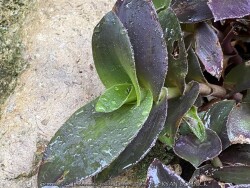
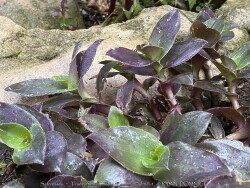

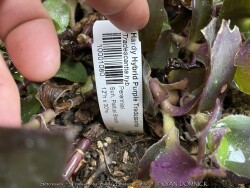
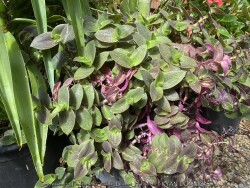
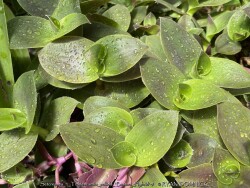
Plant Min Zone: 6b
Plant Max Zone: 11b
Sunlight: All Day Full Sun, Full Sun, Part Sun
Water / Rainfall: Very Low, Low, Average, High
Soil Quality: Poor, Average
Bloom Season: Summer, Late Summer
Flower Color: Pink
Berry / Fruit Color: None
Spring Foliage Color: Purple
Summer Foliage Color: Purple
Fall Foliage Color: Purple
Evergreen Foliage: No
Winter Interest: No
Scented Flowers: No
Drought Tolerance: Medium
Wet-Feet Tolerance: Medium
Humidity Tolerance: High
Wind Tolerance: Medium, High
Poor Soil Tolerance: Sandy Soils, Rocky Soils, Clay Soils
Height: 0.5' - 1'
Width: 1' - 2'
Growth Rate: Medium, Fast
Service Life: Short: 1-3 years
Maintenance Need: Low
Spreading Potential: Low
Yearly Trimming Tips: Trim Perennial to Ground Around First Fall Freeze: No Winter Interest.
Plant Grouping Size: Specimen Planting of 1-3, Small Grouping of 3-5
Best Side of House: South Exposure, West Exposure
Extreme Planting Locations: Survives Severe Drought, Tolerates Extreme Heat, Resistant to Rabbits, Top of Retaining Wall Locations, Base of Retaining Wall Locations
Ornamental Features: Multiple Seasons of Interest, Exceptional / Colorful Foliage
Special Landscape Uses: Groundcover
Possible Pest Problems: None
Plant Limitations: May get Occasional Winter-kill, Needs Thick Winter Mulch
Shippable in 2026: YES
Purple Heart (Setcreasea / Tradescantia pallida) is the most versatile plant in out library: it can be an annual, perennial, patio plant, house plant, or hanging basket in wet or dry soil in full shade or full sun. It can handle growing in standing water or bone dry. In dry soils, it shows no drought stress, continuing to grow with a deeper purple shade. In moist soils, this plant will grow rapidly. In shade, the foliage becomes more greenish but still looks attractive. In Kansas, it is usually grown as an annual. Brilliant purple leaves contrast small pink flowers in the summer! Plants will quickly fill an annual bed with bright purple color all summer til first hard freeze. In the ground, it is possible to overwinter these in the ground in Kansas by placing a giant 6-8" mound of mulch over deeply planted rhizomes. Not sure what's easier, buying and moving that much mulch or replanting in spring?: you decide. If growing as a potted plant and trying to overwinter, allowing the foliage to frost is ok, it will not kill the root system. However, do not allow the pot with rootball to freeze solid or go below 20 degrees for more than a few hours. Allow to go dormant as needed with little care, just cut off dead foliage and place back out in April or May with a time-release fertilizer. Many plants will die back slowly and remain attractive inside for most of the winter. Purple heart plants have no insect, disease or animal pests. Botanical name has recently changed from Setcreasea to Tradescantia. The 'Hardy' form (Setcreasea / Tradescantia pallida 'Bustani Hybrid'), originally purchased at Bustani Plant Farm in Stillwater OK, may have a better chance of surviving winter as a perennial but would still mulch heavy in Kansas. We have not tested this variety for outdoor hardiness in our Lawrence, KS (zone 6a) garden yet (2022). This form also has much more compact foliage and dense root system. When grown in a hanging basket, the foliage creates a nice purple globe effect.